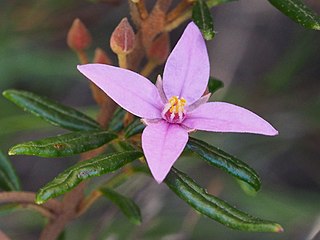
Boronia muelleri, commonly known as the forest boronia or pink boronia, is a flowering plant that occurs in forest, woodland and heath in Victoria and New South Wales in Australia. It is an erect, woody shrub or small tree with pinnate leaves and up to fifteen pink to white four-petalled flowers arranged in leaf axils in spring and summer.

Boronia fraseri, commonly known as Fraser's boronia, is a plant in the citrus family occurring near Sydney in Australia. It is an erect, multi-branched shrub with pinnate leaves and pink flowers arranged in small groups in the leaf axils.

Boronia mollis, commonly known as soft boronia, is a plant in the citrus family and is endemic to New South Wales. It is a shrub with pinnate leaves, and small groups of pink flowers in leaf axils. It grows in coastal areas in forest.

Cyanothamnus anemonifolius, commonly known as narrow-leaved boronia or sticky boronia, is a flowering plant that is endemic to south-eastern Australia. It is a shrub with mostly pinnate leaves, with white to pale pink four-petalled flowers in leaf axils.

Boronia keysii, commonly known as Keys boronia, is a flowering plant that is endemic to Queensland in Australia. It is a sprawling shrub with thin stems, hairy young shoots, pinnate leaves and pink, four-petalled flowers over a long period.

Boronia citriodora, commonly known as lemon-scented boronia, lemon plant or lemon thyme, is a woody shrub that is endemic to Tasmania. It has pinnate leaves and white to pink flowers that are arranged singly or in groups of up to seven, in the leaf axils or on the ends of the branches.

Boronia fastigiata, commonly known as bushy boronia, is a plant in the citrus family, Rutaceae and is endemic to the south-west of Western Australia. It is an erect shrub with small leaves and small groups of red, pink or purple, four-petalled flowers near the ends of the branches.

Boronia angustisepala is a plant in the citrus family Rutaceae and is endemic to New South Wales, Australia. It is an erect shrub with many branches, pinnate leaves with up to eleven leaflets, and bright pink, four-petalled flowers.

Boronia decumbens is a plant in the citrus family Rutaceae and is endemic to northern parts of the Northern Territory. It is a low, spreading shrub with pinnate leaves and white to pink flowers with the four sepals larger than the four petals.

Boronia dichotoma is a plant in the citrus family, Rutaceae and is endemic to the south-west of Western Australia. It is an erect, slender perennial herb or shrub with simple leaves and pink, four-petalled flowers. The species is characterised by sticky glandular hairs on the pedicels.

Boronia elisabethiae is a plant in the citrus family Rutaceae and is endemic to Tasmania. It is a semi-erect or weakly spreading, woody shrub with pinnate leaves and white to pink, four-petalled flowers.
Boronia interrex, commonly known as the Regent River boronia, is a plant in the citrus family, Rutaceae and is endemic to a small area in the Kimberley region of Western Australia. It is an erect, sometimes low-lying shrub with pinnate leaves, cream-coloured to pale pink sepals and pink petals, the sepals longer and wider than the petals.

Boronia kalumburuensis is a plant in the citrus family Rutaceae and is endemic to the Kalumburu area of Western Australia. It is an erect or sprawling shrub with many branches, pinnate leaves and white to pink four-petalled flowers with the sepals longer and wider than the petals.
Boronia minutipinna is a plant in the citrus family Rutaceae and is endemic to a small area in the Kimberley region of Western Australia. It is an erect shrub with many branches, hairy stems and leaves, pinnate leaves and white to pink, four-petalled flowers with the sepals longer and wider than the petals.

Boronia oxyantha is a plant in the citrus family, Rutaceae and is endemic to a small area in the south-west of Western Australia. It is a shrub with many hairy branches, pinnate leaves and pink, four-petalled flowers that have a darker midrib.

Cyanothamnus ramosus is a species of plant in the citrus family Rutaceae and is endemic to the southwest of Western Australia. It is an erect, mostly glabrous shrub with pinnate leaves with up to seven leaflets, and white, four-petalled flowers with blue or pale green backs.

Boronia rubiginosa is a plant in the citrus family Rutaceae and is endemic to New South Wales in Australia. It is a shrub with pinnate leaves that are paler on the lower surface, and up to three pale to bright pink, four-petalled flowers in the leaf axils.

Boronia squamipetala is a species of plant in the citrus family, Rutaceae, and is endemic to Queensland, Australia. It is an erect shrub with pinnate leaves with between five and thirteen elliptic leaflets, and green to white, four-petalled flowers with hairy backs.

Boronia stricta is a plant in the citrus family, Rutaceae and is endemic to near-coastal areas of the south-west of Western Australia. It is a slender shrub with often crowded pinnate leaves with linear leaflets, and pink, four-petalled flowers borne singly or in groups of two or three in leaf axils.

Boronia wilsonii is an erect shrub that is endemic to northern Australia. Its branches, leaves and backs of the flowers are densely covered with woolly hairs. The petals are white to pink or burgundy-coloured.



















